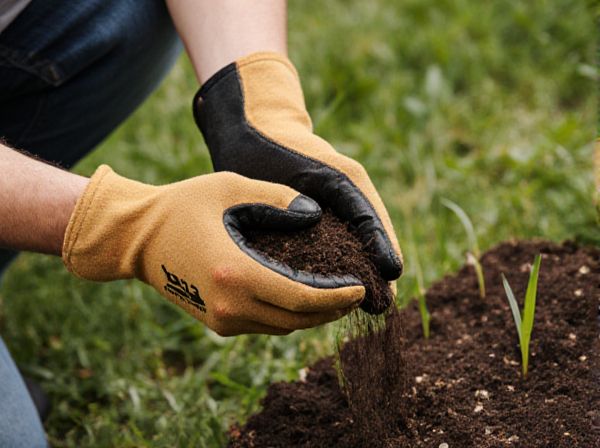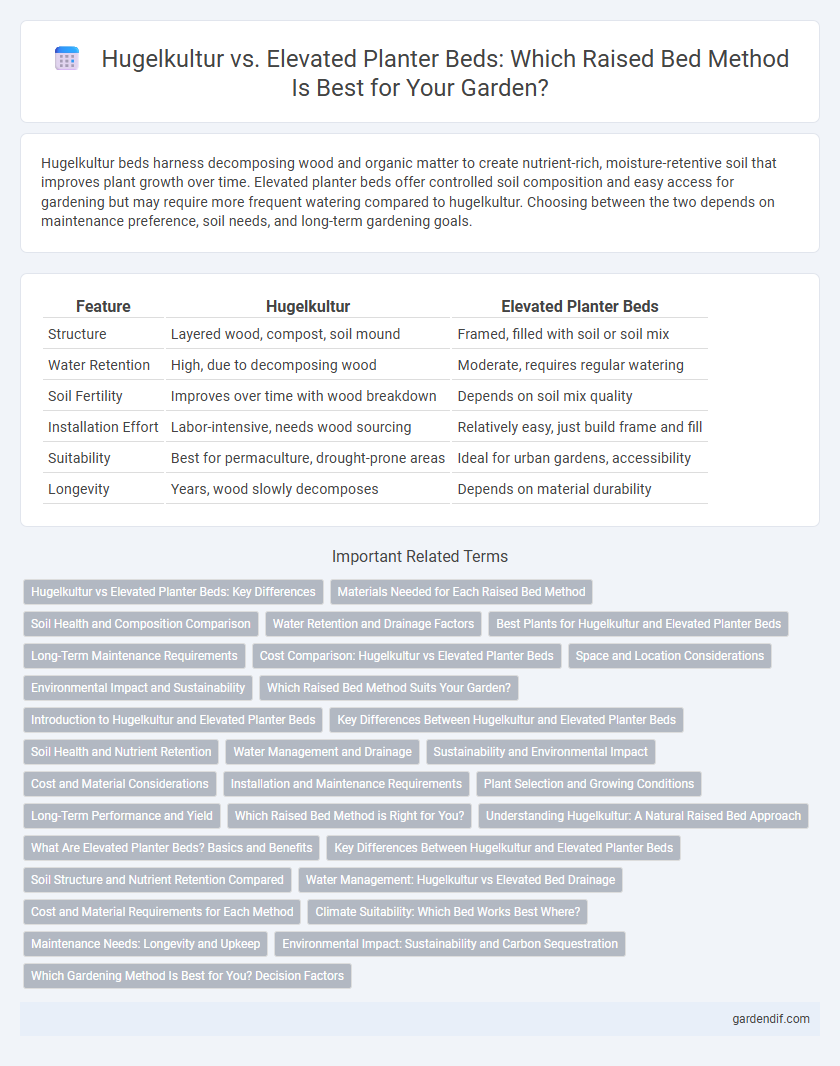
Hugelkultur vs Elevated planter beds Illustration
Hugelkultur beds harness decomposing wood and organic matter to create nutrient-rich, moisture-retentive soil that improves plant growth over time. Elevated planter beds offer controlled soil composition and easy access for gardening but may require more frequent watering compared to hugelkultur. Choosing between the two depends on maintenance preference, soil needs, and long-term gardening goals.
Table of Comparison
| Feature | Hugelkultur | Elevated Planter Beds |
|---|---|---|
| Structure | Layered wood, compost, soil mound | Framed, filled with soil or soil mix |
| Water Retention | High, due to decomposing wood | Moderate, requires regular watering |
| Soil Fertility | Improves over time with wood breakdown | Depends on soil mix quality |
| Installation Effort | Labor-intensive, needs wood sourcing | Relatively easy, just build frame and fill |
| Suitability | Best for permaculture, drought-prone areas | Ideal for urban gardens, accessibility |
| Longevity | Years, wood slowly decomposes | Depends on material durability |
Hugelkultur vs Elevated Planter Beds: Key Differences
Hugelkultur beds consist of decomposing wood and organic materials buried beneath soil, promoting moisture retention and nutrient cycling, while elevated planter beds are typically constructed frames filled with loose soil or compost to improve drainage and accessibility. Hugelkultur leverages natural decomposition to create a self-sustaining ecosystem requiring less frequent watering, whereas elevated planter beds rely more on regular irrigation and soil amendments. The key difference lies in Hugelkultur's integration of wood biomass as a core structure versus the synthetic or wooden framing of elevated planter beds.
Materials Needed for Each Raised Bed Method
Hugelkultur raised beds require large quantities of woody debris such as logs, branches, and wood chips, along with soil and compost to create a nutrient-rich, moisture-retentive mound. Elevated planter beds primarily need quality lumber or metal frames, durable hardware, and a well-draining soil mix enriched with organic matter for optimal plant growth. Using biodegradable materials in hugelkultur promotes natural decomposition, whereas elevated beds emphasize structural stability and longevity with treated or rot-resistant materials.
Soil Health and Composition Comparison
Hugelkultur beds enhance soil health by incorporating decomposing wood and organic matter, which improves moisture retention, nutrient availability, and microbial activity over time. Elevated planter beds typically use a controlled soil mix, providing consistent nutrient levels but less organic matter diversity and slower development of beneficial soil ecosystems. Hugelkultur promotes long-term soil fertility and structure, whereas elevated beds offer immediate planting convenience with less natural soil enrichment.
Water Retention and Drainage Factors
Hugelkultur beds excel in water retention due to their core of decomposing wood, which acts like a sponge absorbing and slowly releasing moisture, making them ideal for drought-prone areas. Elevated planter beds offer superior drainage through built-up soil layers, preventing waterlogging and root rot, which is essential for plants that require well-drained soil. Comparing water dynamics, hugelkultur retains moisture for extended periods, while elevated planters provide rapid drainage, allowing gardeners to choose based on specific moisture needs.
Best Plants for Hugelkultur and Elevated Planter Beds
Hugelkultur beds thrive with moisture-loving plants such as tomatoes, cucumbers, squash, and beans, benefiting from decomposing wood that retains water and nutrients. Elevated planter beds are ideal for herbs like basil, thyme, and parsley, as well as lettuce and radishes, due to improved drainage and soil temperature control. Both systems support diverse plant choices but hugelkultur excels with deep-rooted and resilient crops, while elevated planters favor shallow-rooted, fast-growing varieties.
Long-Term Maintenance Requirements
Hugelkultur beds require minimal long-term maintenance due to their self-sustaining decomposition of woody materials, which improves soil fertility over time. Elevated planter beds demand regular soil replenishment and drainage management to prevent nutrient depletion and waterlogging. The organic matter in hugelkultur beds gradually breaks down, reducing the need for frequent amendments compared to elevated planter beds.
Cost Comparison: Hugelkultur vs Elevated Planter Beds
Hugelkultur beds typically cost less to build as they utilize decomposing wood and organic materials readily available on-site, minimizing the need for purchased soil or lumber. Elevated planter beds require buying lumber, hardware, and often high-quality soil or potting mix, leading to higher upfront expenses. Over time, hugelkultur beds may reduce maintenance costs due to improved moisture retention and soil fertility compared to elevated planters that often need regular watering and soil replacement.
Space and Location Considerations
Hugelkultur beds require ample space due to their mound-like structure, making them ideal for larger gardens or areas with abundant organic debris. Elevated planter beds are more space-efficient and versatile, suited for patios, balconies, or compact gardens where horizontal space is limited. Location factors such as sunlight exposure and soil drainage are critical for both, but hugelkultur beds benefit from well-drained slopes while elevated planters adapt easily to varied environments.
Environmental Impact and Sustainability
Hugelkultur beds enhance environmental sustainability by recycling woody debris, improving soil moisture retention, and promoting biodiversity through natural decomposition processes. Elevated planter beds, while convenient for accessibility, often require manufactured materials and increased water use, which can lead to higher environmental footprints. Choosing hugelkultur supports carbon sequestration and reduces waste, making it a more eco-friendly option for sustainable gardening.
Which Raised Bed Method Suits Your Garden?
Hugelkultur raised beds use decomposing wood and organic matter to create nutrient-rich, moisture-retentive soil, ideal for gardeners seeking sustainability and extended water retention. Elevated planter beds are constructed with durable materials and provide improved accessibility and soil control, making them suitable for urban gardeners or areas with poor native soil. Selecting between hugelkultur and elevated planters depends on garden size, maintenance capacity, and environmental conditions such as moisture availability and soil quality.
Hugelkultur vs Elevated planter beds Infographic

 gardendif.com
gardendif.com